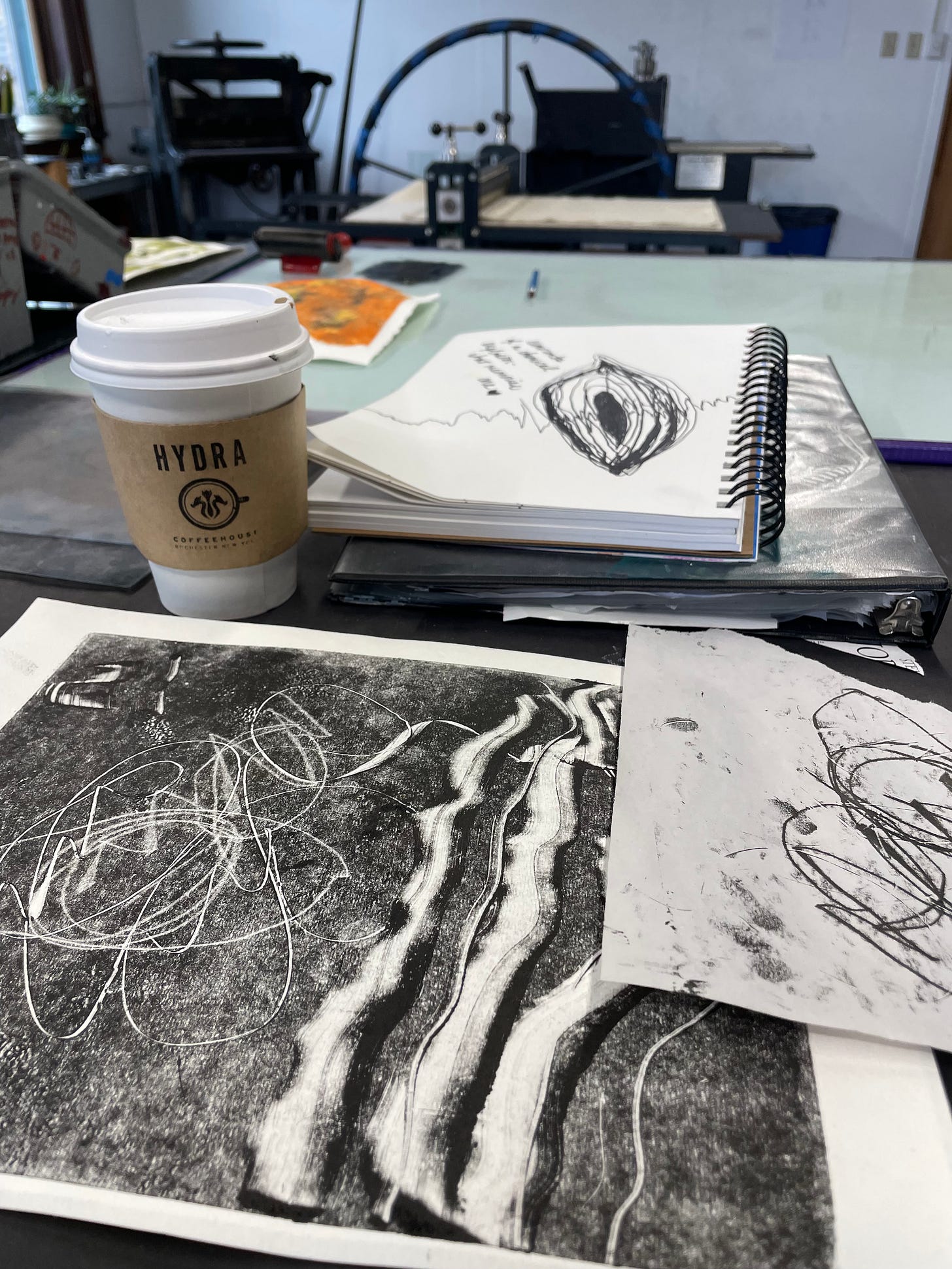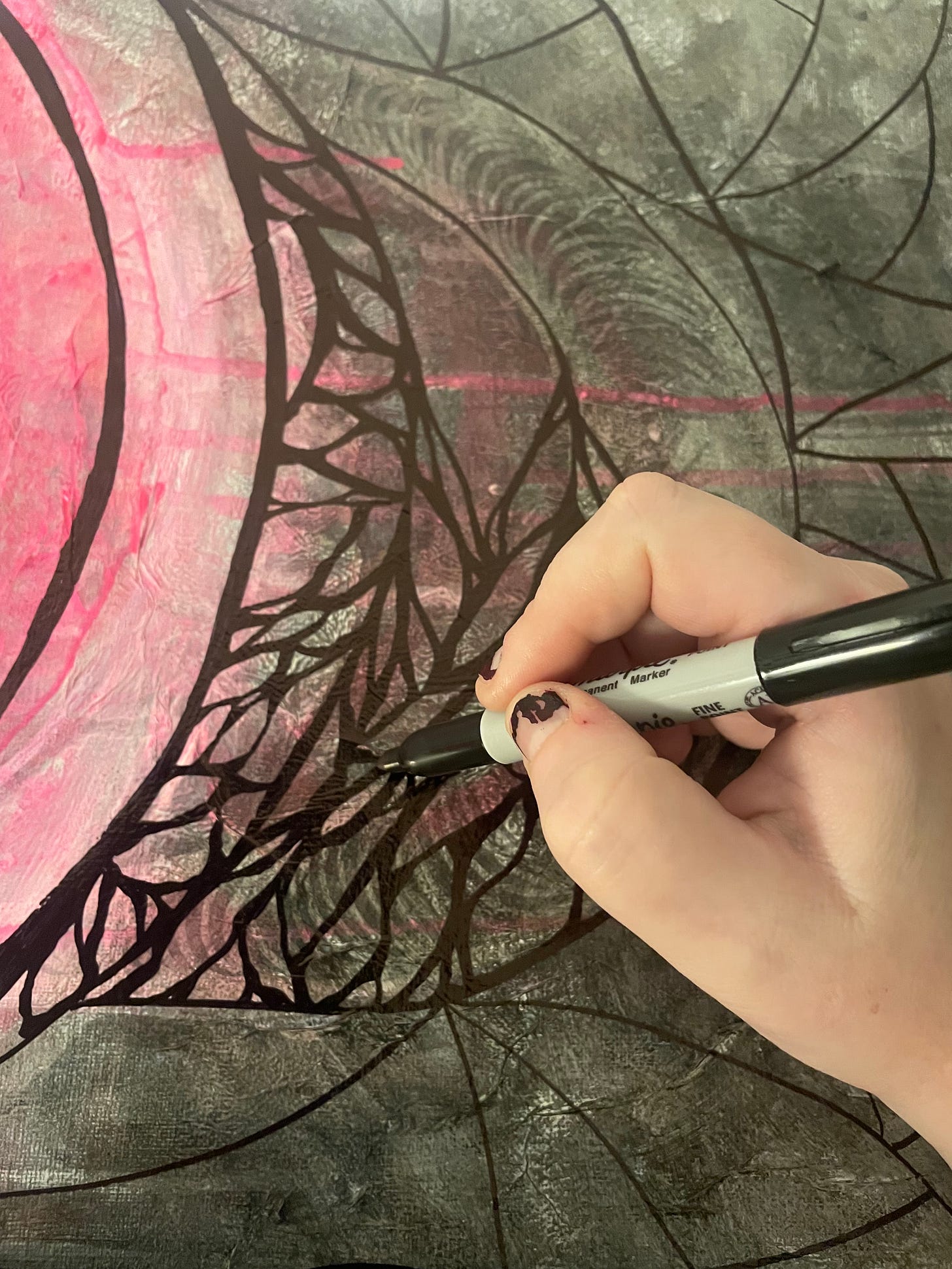Relearning Creativity: Navigating the 40-Hour Workweek as an Artist
Welcome to Compost & Creation, where the mess becomes the magic. This is where I sift through the scraps—art, memory, resistance, wonder—and turn them into something new. If you're into creative process deep dives, raw reflections, and the occasional existential pep talk, you’re in the right place.
Subscribe to get dat fresh compost delivered straight to your inbox. If you become a paying subscriber, you get even more behind the scenes/raw/in process writing of my memoir, working title I’m Glad I Didn’t Die.
Let’s make something from all this:
Look! A wild artist appeared…
I’ve been wanting to write this essay for weeks now. I’ve been back in the full time workforce as an art teacher to adults with disabilities for over 7 months now. That’s long enough for me to get into it, figure the job out, realize that my relationship to creativity has shifted drastically, freak out and then do something about it. LOL… I’m still very much in process (aren’t we ALL?!) but I wanted to share the things I’ve learned from this season of life so far. Ready?
For seven years, I lived the freelance artist life—piecing together creative projects, coaching, exhibitions, and commissions, all while navigating the uncertainty of self-employment. It was a life of autonomy, slow mornings, and deep creative exploration, but it was also a life of financial unpredictability.
As a divorced mom who pays child support, I reached a point where I had to rebuild my financial foundation. The instability of freelancing wasn’t sustainable, and I knew I needed a full-time job to regain a sense of security. The transition back to a 40-hour workweek wasn’t just a career shift—it was a full-body recalibration.
The Shock of Structure
The first few weeks were brutal. My body, used to a slower rhythm, had to build stamina. I was exhausted, sick often, and overwhelmed by the sheer energy output required every day. But it was also validating—I got hired in a teaching position, proving to myself that the years of experience and degrees I had accumulated still meant something. There was comfort in a steady paycheck, a relief in no longer having to wonder where the money would come from each month. I even started going to the gym BEFORE work three days a week, and it’s wild how much that helps… even if I don’t quite recognize myself yet in this season.
Yet, the reality of full-time work hit harder than expected. The job requires me to be on constantly, supporting others in a way that left me drained at the end of most days. I quickly burned out. I underestimated how much I would have to rework my creative practice—not just in terms of time, but in how I approached creativity altogether.
My identity, once so wrapped up in being a full-time artist, had to stretch to include something new.
Rebuilding My Creative Practice
For a while, I felt lost. Too tired to create, too drained to even think about making art. Creativity, once the core of my day, now felt like an afterthought squeezed into the margins of my life, and that made me big sad.
But I knew from experience—creative droughts don’t last forever. Droughts are just seasons asking to be heard.
So I began experimenting. I started keeping a sketchbook with me at all times, doodling when I could. I carved out small moments—scribbling in my notebook before diving into paperwork, using my lunch break to recharge creatively. I had to learn, over and over, that no one was going to hand me time to create. I had to take it.
One of the most surprising sources of inspiration has been collaboration. My job allows me to create alongside the people I support, and that’s opened up new ways of playing with art. Sometimes I’ll start a drawing and have a student finish it. Sometimes my co-teacher and I will swap canvases and see what the other will do to add to the composition. It’s not the same as my personal practice, but it keeps the creative muscles from atrophying. And, it helps me stay loose.
Redefining Creativity in This Season
This transition has forced me to redefine what being an artist means to me. Before, it was tied to my job title, my income, my ability to produce work. Now, I see it differently. Being an artist isn’t about how much I create or whether I’m doing it full-time. It’s just who I am. Period.
I don’t have the luxury of spontaneity anymore, so I’m learning to plan for creativity. Yeah, I KNOW! It doesn't sound as sexy, but planning for play is absolutely vital for adults who have many many responsibilities. It won’t just magically happen. I’m currently working on a big exhibition that will debut in August. My collaborator and I, both moms, are scheduling studio time months in advance because we have to. It’s very heartening to work this way, knowing that I’m one of many humans who find time in their day where they can find it.
I’m integrating small rituals—morning journaling, lighting incense after work and setting a timer for 20 minutes of unstructured play. These are small acts, but they tether me back to myself, back to my humanity and my art making practice.
Most of all, I’m practicing self-compassion. It’s easy to mourn the artist I used to be, but I’m learning to trust that this season is shaping something new; integrating all the old parts and shaping them into a form that fits this life season. It’s an evolving process. Art as a way of LIFE, okay?? I remind myself: conditions will never be optimal.
If I wait for the perfect moment to create, I’ll spend all my time cleaning my studio instead.
The Path Forward
I don’t know if this shift is temporary or if it’s leading me toward something else. What I do know is that adaptability is key. Right now, I’m working full-time, training for a new role (I got promoted!), and finding ways to create in between. In the future, who knows? But for now, I’m learning that being an artist is not about when or how much I create—it’s about continuing to show up, even if it’s just for ten minutes a day.
For any other artists navigating this kind of transition, here’s what I’ve learned along the way:
Advice for Artists Returning to Full-Time Work
Give yourself grace. This transition is huge, and your nervous system needs time to adjust. Creativity will come back, but first, you need to get your footing.
Redefine what being an artist means to you. It doesn’t have to mean “full-time” or “producing constantly.” Your identity as an artist doesn’t disappear just because you’re earning a paycheck another way.
Make art easy to access. Keep a sketchbook with you. Scribble on napkins. Use small pockets of time to keep the creative muscle active.
Schedule your creativity. If spontaneity isn’t an option, plan ahead. Block off creative time like you would a meeting or appointment—your art deserves space in your life. (parents and caregivers, I’m looking at YOU especially)
Create rituals to shift into creative mode. Light a candle, set a timer, put on a playlist—whatever helps signal to your brain that it’s time to make.
Don’t wait for the perfect conditions. You will never have enough time, space, or energy. Create anyway.
Experiment and stay open. Your creative practice might look different now. Try new materials, new approaches—let yourself be surprised.
Collaborate when possible. Sometimes, making art with others can be easier and more fulfilling than making it alone.
Rest intentionally. Not all rest is the same. Sometimes you need a nap. Sometimes you need movement. Sometimes you need to play. Find what recharges you.
Trust that the drought won’t last forever. You may feel disconnected now, but creativity is cyclical. The ideas, the inspiration, the energy—they will return.
And above all else, just keep showing up for yourself. Even if it’s five minutes at a time. Even if it’s just a doodle or a scribbled thought in the margins of your day. That’s how you rebuild creative self-trust. That’s how you make it through.
Because after the drought comes the deluge!
It’s all compost. Let’s make something with it.
xoxo,
Molly
Fresh Layers: What’s on repeat this week?
RORY is an artist that I just discovered recently. She’s in her forties, and has a story that I resonate with deeply. The lyrics for this song in particular hit that idea of being afraid of being too late to do something in life. Spoiler alert: it’s never too late. I recommend listening to her entire album front to back for the full story.
Bonus points if you’re someone like me who grew up in the church, and evolved/left/deconstructed/synthesized all those experiences as someone exploring multiple identities… this music is just damn good, okay? Slaps, as the kids say.





I struggled with the same experience as a writer after leaving college where I had creative time in abundance, even a mandate to create from writing classes, to 40+ hours of work a week. Although I still haven’t found the “perfect schedule” or reached an output that feels anything like enough, I’ve made progress. I write on the weekends and on the train. Thanks for the reminder to keep going!
Brilliant and timeless, my love 💜 😍💐